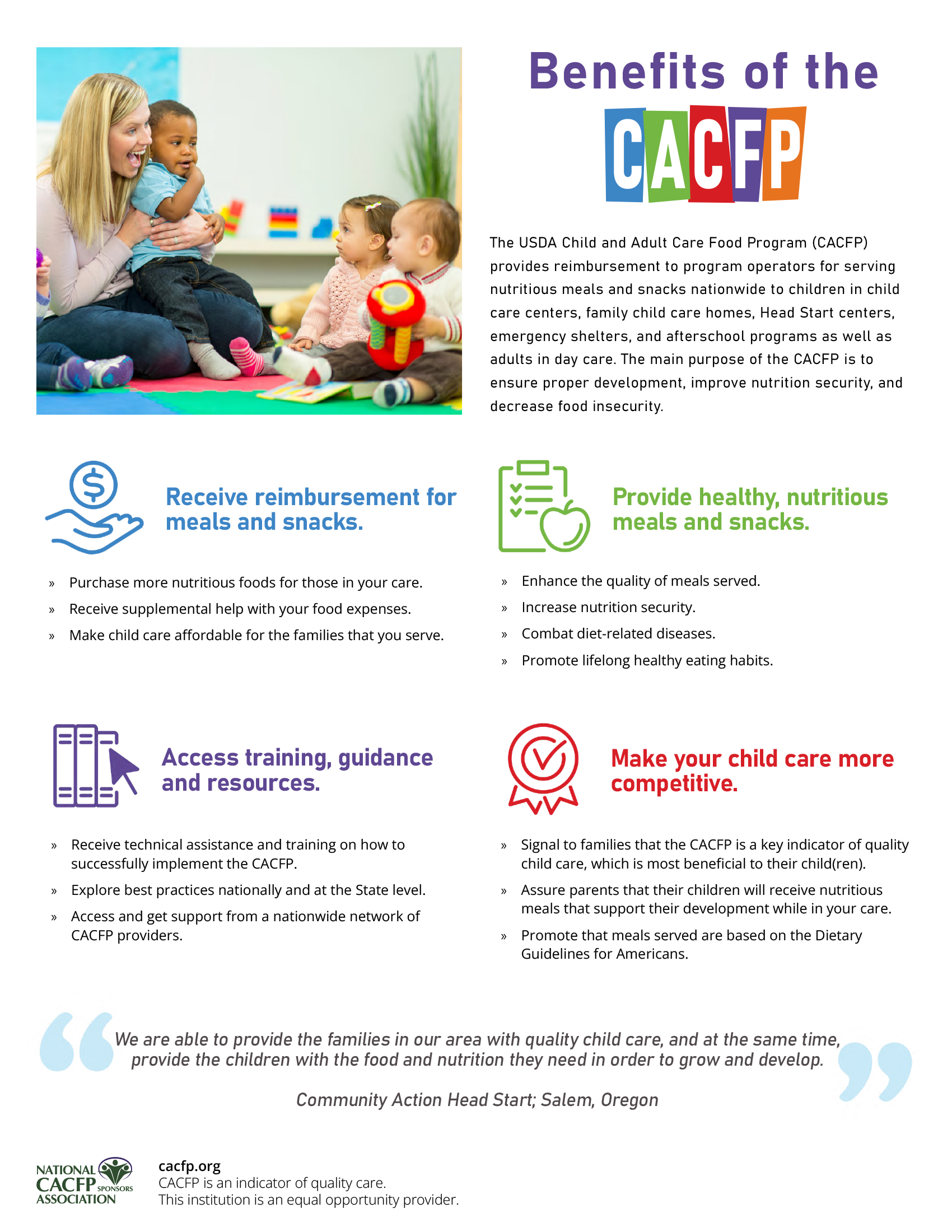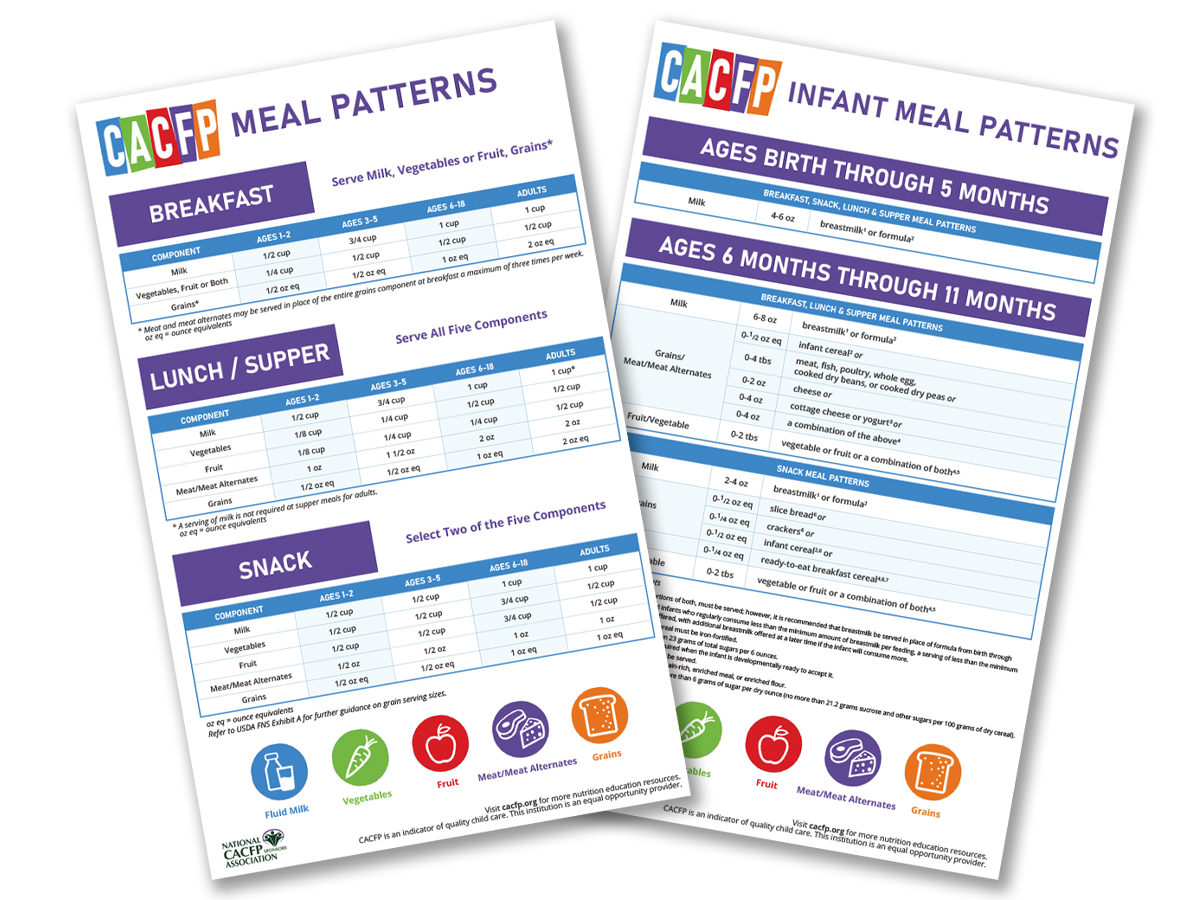
The Child and Adult Care Food Program (CACFP) is a federal program that provides reimbursements for nutritious meals and snacks served to eligible infants, children and adults. These participants can be at child care centers, day care homes, adult day care centers, at-risk afterschool care centers, and emergency shelters.

Reimbursement for CACFP participants is dependent upon a variety of factors, such as what type of facility is administering the CACFP, the income level of participants and the income level of the area. To find out what your income/area eligibility and reimbursement rates would be, please use the following links.
The CACFP nutrition standards are based on the Dietary Guidelines for Americans, science-based recommendations made by the National Academy of Medicine, cost and practical considerations, and stakeholder input. There are five meal components: Grain, Vegetable, Fruit, Meat/Meat Alternate and Fluid Milk. In order to be reimbursed, the meal or snack must contain the required components in their minimum amounts by age.


If you operate a child care center, family child care home or adult day care center, you may claim up to 2 meals and 1 snack OR 2 snacks and 1 meal per participant, per day.
At-risk afterschool centers may claim up to 1 meal and 1 snack per child, per day.
Emergency shelters may claim up to 3 meals OR 2 meals and 1 snack per child, per day.
The USDA Food and Nutrition Service updates the reimbursement rates every year. They are valid from July 1 to June 30 of the following year.
There are many great resources for you to determine if your meals and snacks are #CACFPCreditable!
The Food Buying Guide for Child Nutrition Programs (FBG) is the principal tool that is used to determine the contribution that foods make towards meal requirements, regarless of if foods are produced onsite or purchased commercially. In addition to using search tools to find creditable foods, you can also use the Recipe Analysis Workbook (RAW) to determine the crediting for your own recipes.
Additionally, you can use the Crediting Handbook as a supplement to the Food Buying Guide, as it contains additional information on creditable foods in child and adult care centers, outside-school-hours care centers, and family day care homes.
Finally, to navigate the finer details of crediting foods, be sure to check out our Meal Patterns page for USDA and NCA resources.
All five components (grains, vegetable, fruit, meat/meat alternate and fluid milk) must be served at lunch and/or supper.
Three components must be served during breakfast. Fluid milk and grains are required for all breakfasts. The third component must be either a vegetable, fruit or a mix of both.
Snacks must be two different components of your choice (i.e. grains and milk, fruit and vegetable, meat alternate and grains, etc.)
You must meet the minimum serving size, as determined on the meal pattern cards for each age group, in order to be reimbursed.
Additionally, at least one serving of grains per day must be whole grain-rich in order for the day's meals and snacks to be reimbursed (excluding children under 1 year old).
Food substitutions and other reasonable modifications to the CACFP meal pattern may be necessary to mee the dietary needs of participants who:
For participants with disabilities, USDA requires that CACFP facilities make modifications on a case-by-case basis.
If the meal modification does not meet the meal pattern requirements, a medical statement from a licensed physician or licensed health care professional who is authorized to write medical prescriptions under State law (health care professional) must be provided. Meals that do not meet the CACFP meal pattern requirements are not eligible for reimbursement unless they are supported by a medical statement.
The medical statement , signed by a State recognized licensed healthcare professional, should include a description of the child’s or adult’s disability so that providers understand how it restricts the child’s or adult’s diet. The statement should also describe what must be done to accommodate the disability. This may include what foods should not be served and recommendations for what should be served. A medical statement is required to justify reimbursement for the modified meal. This statement should be kept on file at the center or day care home.
For participants without disabilities, the CACFP regulations allow, but do not require, meal modifications. Examples of optional meal modifications include requests related to religious or moral beliefs, general health concerns, and personal food preferences. USDA exemptions include sponsors of Jewish and Seventh-day Adventist institutions.
Yes, but there are minimum serving requirements in order to count towards the crediting.
Whole grain-rich (WGR) means that at least 50 percent of the grain ingredients of the food are whole grains, and any other grains are enriched. At least one serving of grains per day must be WGR (excluding for children under 1 year old).
There are six methods to determine if a food item is WGR):
There are many resources on our Meal Patterns page that can help you determine if you're serving a whole-grain rich food, such as our Identifying Whole Grain-Rich Guide .
In addition to the standards for WGR, all grain products served in the CACFP must be made with whole grains or enriched meal and/or enriched flour, or bran, or germ, to be creditable.
Ounce equivalents (oz eq) tell you the amount of grain in a portion of food. When serving a grain, you will need to identify how many ounce equivalents are in each serving based on the product and its weight.
For example, to meet 1 oz eq of grains, you would need to serve:
These are general rules for the grain types. Please use the Food Buying Guide or the Using Ounce Equivalents for Grains Worksheet to make sure you're serving the correct oz eq. There are also more resources on our Meal Patterns page .
We're here to help! Here are some of the pages that can help you navigate the nuances of the food program:
We also post our Meal Pattern Minute on social media for those quick tips that sometimes slip through the cracks in the big picture of the food program. Be sure to f ollow us on Instagram or on Facebook for more tips, recipes and resources!
And finally, we encourage you to attend the National Child Nutrition Conference or check out some of the webinars that we hold in our Event Calendar , much of which can also count towards any continuing education certifications you may pursue.